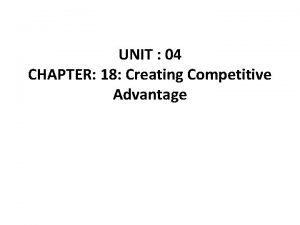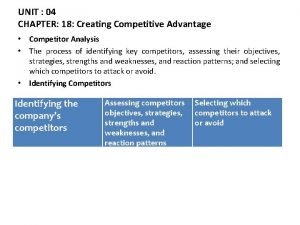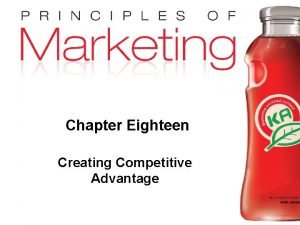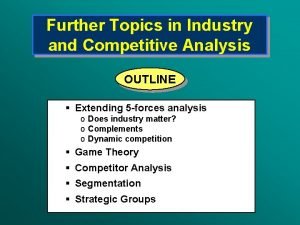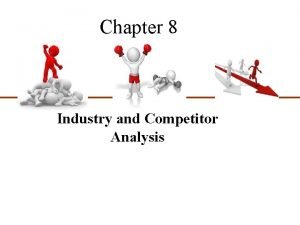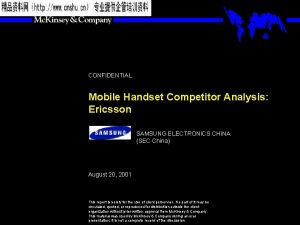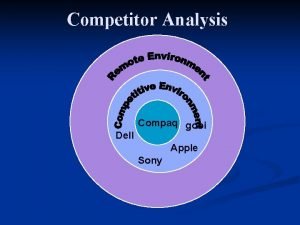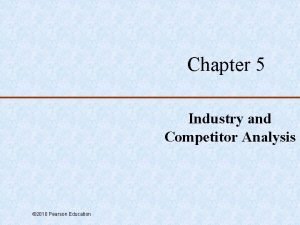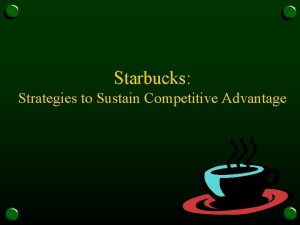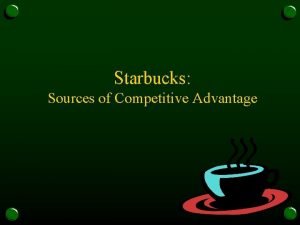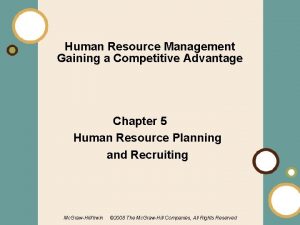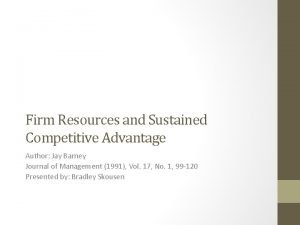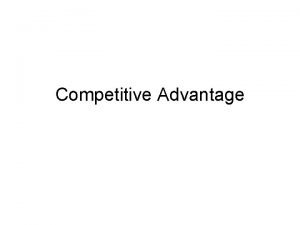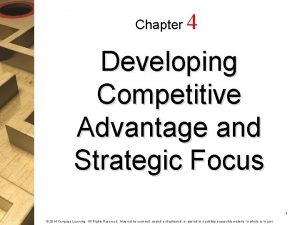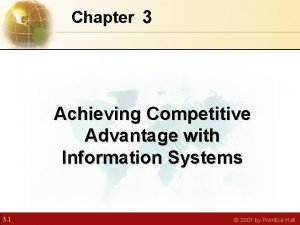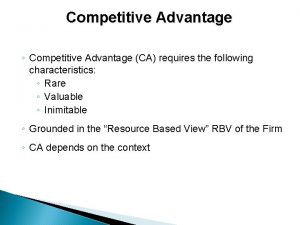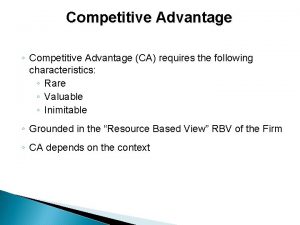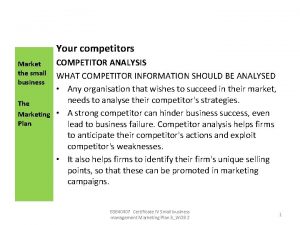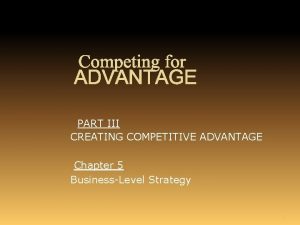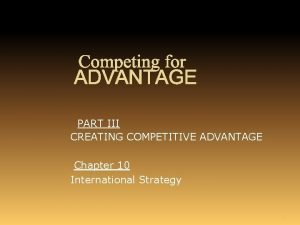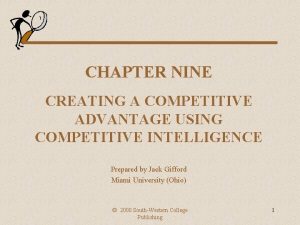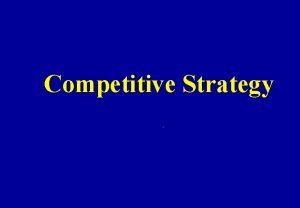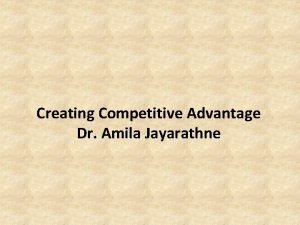LECTURE29 Creating Competitive Advantage Topic Outline Competitor Analysis



































- Slides: 35

LECTURE-29 Creating Competitive Advantage

Topic Outline § Competitor Analysis § Competitive Strategies § Balancing Customer and Competitor Orientations

Today’s Companies § Competitive advantages require delivering more value and satisfaction to target consumers than competitors do § Competitive marketing strategies are how companies analyze their competitors and develop value-based strategies for profitable customer relationships

Competitor Analysis Competitor analysis is the process of identifying, assessing, and selecting key competitors

Competitor Analysis Identifying Competitors § Competitors can include: § All firms making the same product or class of products § All firms making products that supply the same service § All firms competing for the same consumer dollars

Competitor Analysis Assessing Competitors Competitor’s objectives • • Profitability Market share growth Cash flow Technological leadership • Service leadership Competitor’s strategies • Strategic group offers the strongest competition

Competitor Analysis Assessing Competitors Competitor’s strengths and weaknesses • What can our competitors do? • Benchmarking Estimating competitor’s reactions • What will our competitors do?

Competitor Analysis Selecting Competitors to Attack and Avoid Customer value analysis determines the benefits that target customers’ value and how customers rate the relative value of various competitors’ offers § Identification of major attributes that customers value and the importance of these values § Assessment of the company’s and competitors’ performance on the valued attributes

Competitor Analysis Selecting Competitors to Attack and Avoid § Close or distant competitors § Good or bad competitors

Competitor Analysis Selecting Competitors to Attack and Avoid Finding uncontested market spaces: § Rather than competing head to head with established competitors, many companies seek out unoccupied positions in uncontested market spaces. § They try to create products and services for which there are no direct competitors.

Competitor Analysis § § § § Designing a Competitive Intelligence System Identifies competitive information and the best sources of this information Continually collects information Checks information for validity and reliability Interprets information Organizes information Sends key information to relevant decision makers Responds to inquiries about competitors

Competitive Strategies Approaches to Marketing Strategy Entrepreneurial marketing involves visualizing an opportunity and constructing and implementing flexible strategies Formulated marketing involves developing formal marketing strategies and following them closely Intrepreneurial marketing involves the attempt to reestablish an internal entrepreneurial spirit and refresh marketing strategies and approaches

Competitive Strategies Basic Competitive Strategies Michael Porter’s four basic competitive positioning strategies Overall cost leadership Differentiation Focus Middle of the road

Competitive Strategies Basic Competitive Strategies Overall cost leadership strategy: a company achieves the lowest production and distribution costs and allows it to lower its prices and gain market share

Competitive Strategies Basic Competitive Strategies Differentiation strategy is when a company concentrates on creating a highly differentiated product line and marketing program so it comes across as an industry class leader Focus strategy is when a company focuses its effort on serving few market segments well rather than going after the whole market

Competitive Strategies Basic Competitive Strategies A company that pursued a clear strategy would achieve superior performance Companies without a clear strategy, “middle of the road”, would not succeed No clear strategy is

Competitive Strategies Basic Competitive Strategies Michael Treacy and Fred Wiersema suggest companies can gain leadership positions by delivering superior value to their customers in three strategies or “value disciplines: ” § Operational excellence § Customer intimacy § Product leadership

Competitive Strategies Basic Competitive Strategies Operational excellence refers to a company providing value by leading its industry in price and convenience by reducing costs and creating a lean and efficient value delivery system

Competitive Strategies Basic Competitive Strategies Customer intimacy refers to a company providing superior value by segmenting markets and tailoring products or services to match the needs of the targeted customers

Competitive Strategies Basic Competitive Strategies Product leadership refers to a company providing superior value by offering a continuous stream of leading-edge products or services. Product leaders are open to new ideas and solutions and bring them quickly to the market.

Competitive Strategies Competitive Positions Market leader strategies Market challenger strategies Market follower strategies Market nicher strategies

Competitive Strategies Market Leader Strategies § Expand total demand § Protect their current market § Expand market share

Competitive Strategies Market Leader Strategies Expanding Total Demand § Expand total demand by developing: § New users § New uses § More usage of its products

Competitive Strategies § § § Market Leader Strategies Protecting Market Share Protect current market by: Fixing or preventing weaknesses that provide opportunities to competitors Maintain consistent prices that provide value Keep strong customer relationships Continuous innovation

Competitive Strategies Market Leader Strategies Expanding Market Share § Expand market share by: § Increasing profitability with increasing market share in served markets § Producing high-quality products § Creating good service experiences § Building close relationships

Competitive Strategies Market Challenger Strategies Challenge the leader with an aggressive bid for more market share Second mover advantage challenger observes what has made the leader successful and improves on it

Competitive Strategies Market Follower Strategies Play along with competitors and not rock the boat Copy or improve on leader’s products and programs with less investment Brings distinctive advantages Must keep costs and prices low or quality and services high

Competitive Strategies Market Nicher Strategies Ideal market niche is big enough to be profitable with high growth potential and has little interest from competitors Key to market niching is specialization § Market § Customer § Product § Marketing mix

Balancing Customer and Competitor Orientations § Companies need to continuously adapt strategies to changes in the competitive environment § Competitor-centered company § Customer-centered company § Market-centered company

Balancing Customer and Competitor Orientations § Competitor-centered company spends most of its time tracking competitor’s moves and market shares and trying to find ways to counter them § Advantage is that the company is a fighter § Disadvantage is that the company is reactive

Balancing Customer and Competitor Orientations Customer-centered company spends most of its time focusing on customer developments in designing strategies Provides a better position than competitorcentered company to identify opportunities and build customer relationships

Balancing Customer and Competitor Orientations Market-centered company spends most of its time focusing on both competitor and customer developments in designing strategies

Balancing Customer and Competitor Orientations

Bibliography § Principles of Marketing by Philip Kotler & Gary Armstrong Fifteenth Edition, Published by Prentice Hall § Marketing Management – A South Asian Perspective by Philip Kotler, Kevin Lane Keller, Abraham Koshy & Mithileshwar Jha, 13 th Edition, Published by Pearson Education, Inc. § Principles and Practices of Marketing by Jobber, D. 4 th edition, Mc. Graw Hill International. § Principles of Advertising & IMC by Tom Duncan 2 nd Edition, Published by Mc. Graw-Hill Irwin.

The End Learn to listen. Opportunity some times knocks very softly.
 Value creation strategy
Value creation strategy Competitor centered company
Competitor centered company Porters 3 generic strategy
Porters 3 generic strategy Chapter 18 creating competitive advantage
Chapter 18 creating competitive advantage Chapter 18 creating competitive advantage
Chapter 18 creating competitive advantage Citation sandwich example
Citation sandwich example Competitive analysis doc
Competitive analysis doc Competitive analysis outline
Competitive analysis outline Industry analysis outline
Industry analysis outline Competitor analysis example in feasibility study
Competitor analysis example in feasibility study Myk pono competitor analysis
Myk pono competitor analysis Objective of industry analysis
Objective of industry analysis Competitor analysis theory
Competitor analysis theory Nokia competitor analysis
Nokia competitor analysis Ericsson axd 320
Ericsson axd 320 Analysis apple fy sony microsofthiggins wall
Analysis apple fy sony microsofthiggins wall Competitive analysis grid example
Competitive analysis grid example Lehmann and winer competitor analysis
Lehmann and winer competitor analysis Competitor analysis theory
Competitor analysis theory Competitor grid
Competitor grid Least competitive market
Least competitive market Therapeutic index
Therapeutic index Rivalry chapter 5
Rivalry chapter 5 Jay b barney
Jay b barney Starbucks competitive strategy
Starbucks competitive strategy Starbucks firm infrastructure
Starbucks firm infrastructure Human resources management gaining a competitive advantage
Human resources management gaining a competitive advantage Downsizing
Downsizing Human resource management gaining a competitive advantage
Human resource management gaining a competitive advantage Levi's competitive advantage
Levi's competitive advantage Firm resources and sustained competitive advantage
Firm resources and sustained competitive advantage Quotes on competitive advantage
Quotes on competitive advantage Bases of competitive advantage
Bases of competitive advantage Four building blocks of competitive advantage
Four building blocks of competitive advantage Developing competitive advantage and strategic focus
Developing competitive advantage and strategic focus Achieving competitive advantage with information systems
Achieving competitive advantage with information systems
